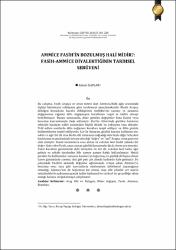Ammice fasih’in bozulmuş hali midir?: Fasih-ammice diyalektiğinin tarihsel serüveni
Künye
Kaplan, A. (2019). Ammice fasih’in bozulmuş hali midir?: Fasih-ammice diyalektiğinin tarihsel serüveni. Bilimname, 38(2), 201-228. https://doi.org/10.28949/bilimname.474870Özet
This study aims to investigate the relationship between eloquent Arabic (fusha) and vernacular Arabic ((c)ammiya) depending on descriptive grammar approach. Unfortunately, the helpful data about pre-Islamic Arabic are limited so that although there are numerous anecdotes reported about variations in pre-Islamic period, these put down on papers after standardization of Arabic. Thus, the available linguistic amount is not enough to compare the standard Arabic with pre-Islamic Arabic. the classical Arabic grammar books built up on a rather prescriptive grammatic model and aimed to reveal the unchanging rules of language. This attitude seems to be affected by oral recitations of the Qur'an, whose language viewed as standard, unchanged, beautiful, powerful and inimitable by humans. As a result, words such as error or decay have been used to describe any kind of difference or manner of speaking that deviates from the standard linguistic way fusha. the attitude toward the modern dialects as `deviations' from the norm is no doubt linked to the understanding of lahn at the early stage of Arabic. It is therefore not surprising that the language guardians use this term to describe modern `deviations' from the fusha, regardless of their sources.


















